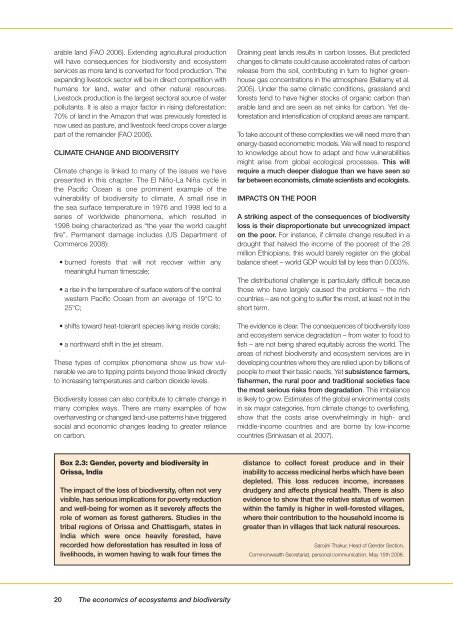Interim Report - TEEB
Interim Report - TEEB
Interim Report - TEEB
You also want an ePaper? Increase the reach of your titles
YUMPU automatically turns print PDFs into web optimized ePapers that Google loves.
arable land (FAO 2006). Extending agricultural production<br />
will have consequences for biodiversity and ecosystem<br />
services as more land is converted for food production. The<br />
expanding livestock sector will be in direct competition with<br />
humans for land, water and other natural resources.<br />
Livestock production is the largest sectoral source of water<br />
pollutants. It is also a major factor in rising deforestation:<br />
70% of land in the Amazon that was previously forested is<br />
now used as pasture, and livestock feed crops cover a large<br />
part of the remainder (FAO 2006).<br />
CLIMATE CHANGE AND BIODIVERSITY<br />
Climate change is linked to many of the issues we have<br />
presented in this chapter. The El Niño-La Niña cycle in<br />
the Pacific Ocean is one prominent example of the<br />
vulnerability of biodiversity to climate. A small rise in<br />
the sea surface temperature in 1976 and 1998 led to a<br />
series of worldwide phenomena, which resulted in<br />
1998 being characterized as “the year the world caught<br />
fire”. Permanent damage includes (US Department of<br />
Commerce 2008):<br />
• burned forests that will not recover within any<br />
meaningful human timescale;<br />
• a rise in the temperature of surface waters of the central<br />
western Pacific Ocean from an average of 19°C to<br />
25°C;<br />
• shifts toward heat-tolerant species living inside corals;<br />
• a northward shift in the jet stream.<br />
`<br />
These types of complex phenomena show us how vulnerable<br />
we are to tipping points beyond those linked directly<br />
to increasing temperatures and carbon dioxide levels.<br />
Biodiversity losses can also contribute to climate change in<br />
many complex ways. There are many examples of how<br />
overharvesting or changed land-use patterns have triggered<br />
social and economic changes leading to greater reliance<br />
on carbon.<br />
Draining peat lands results in carbon losses. But predicted<br />
changes to climate could cause accelerated rates of carbon<br />
release from the soil, contributing in turn to higher greenhouse<br />
gas concentrations in the atmosphere (Bellamy et al.<br />
2005). Under the same climatic conditions, grassland and<br />
forests tend to have higher stocks of organic carbon than<br />
arable land and are seen as net sinks for carbon. Yet deforestation<br />
and intensification of cropland areas are rampant.<br />
To take account of these complexities we will need more than<br />
energy-based econometric models. We will need to respond<br />
to knowledge about how to adapt and how vulnerabilities<br />
might arise from global ecological processes. This will<br />
require a much deeper dialogue than we have seen so<br />
far between economists, climate scientists and ecologists.<br />
IMPACTS ON THE POOR<br />
A striking aspect of the consequences of biodiversity<br />
loss is their disproportionate but unrecognized impact<br />
on the poor. For instance, if climate change resulted in a<br />
drought that halved the income of the poorest of the 28<br />
million Ethiopians, this would barely register on the global<br />
balance sheet – world GDP would fall by less than 0.003%.<br />
The distributional challenge is particularly difficult because<br />
those who have largely caused the problems – the rich<br />
countries – are not going to suffer the most, at least not in the<br />
short term.<br />
The evidence is clear. The consequences of biodiversity loss<br />
and ecosystem service degradation – from water to food to<br />
fish – are not being shared equitably across the world. The<br />
areas of richest biodiversity and ecosystem services are in<br />
developing countries where they are relied upon by billions of<br />
people to meet their basic needs. Yet subsistence farmers,<br />
fishermen, the rural poor and traditional societies face<br />
the most serious risks from degradation. This imbalance<br />
is likely to grow. Estimates of the global environmental costs<br />
in six major categories, from climate change to overfishing,<br />
show that the costs arise overwhelmingly in high- and<br />
middle-income countries and are borne by low-income<br />
countries (Srinivasan et al. 2007).<br />
Box 2.3: Gender, poverty and biodiversity in<br />
Orissa, India<br />
The impact of the loss of biodiversity, often not very<br />
visible, has serious implications for poverty reduction<br />
and well-being for women as it severely affects the<br />
role of women as forest gatherers. Studies in the<br />
tribal regions of Orissa and Chattisgarh, states in<br />
India which were once heavily forested, have<br />
recorded how deforestation has resulted in loss of<br />
livelihoods, in women having to walk four times the<br />
distance to collect forest produce and in their<br />
inability to access medicinal herbs which have been<br />
depleted. This loss reduces income, increases<br />
drudgery and affects physical health. There is also<br />
evidence to show that the relative status of women<br />
within the family is higher in well-forested villages,<br />
where their contribution to the household income is<br />
greater than in villages that lack natural resources.<br />
Sarojini Thakur, Head of Gender Section,<br />
Commonwealth Secretariat, personal communication, May 15th 2008.<br />
20 The economics of ecosystems and biodiversity

















